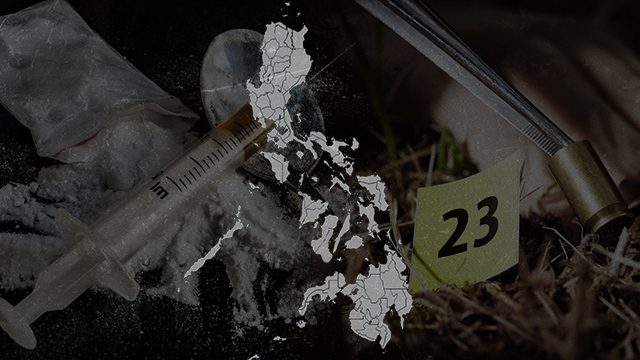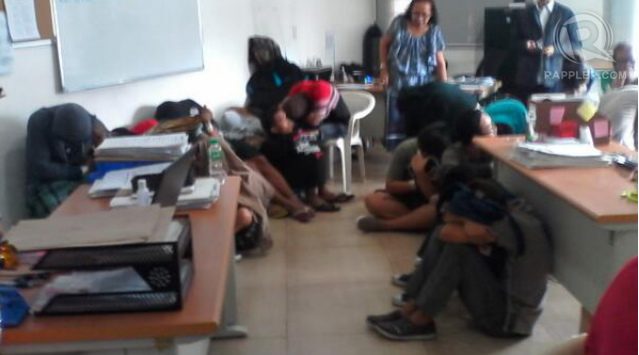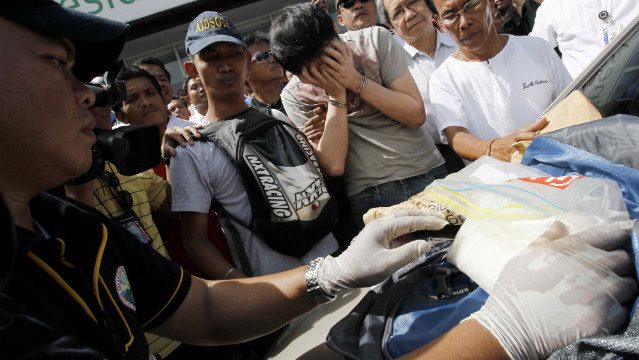SUMMARY
This is AI generated summarization, which may have errors. For context, always refer to the full article.

MANILA, Philippines – Crime and drugs are social ills that need to be stamped out, say Rodrigo Duterte and Alan Peter Cayetano as they seek the two highest positions in the land in 2016.
Duterte used a peace and order platform before, when he first ran for Davao City mayor in 1988. He later earned a reputation for his iron-fisted approach to criminality. Davao City now enjoys a state-of-the-art crime response center and was named 9th safest city in the world in 2015.
On Tuesday, January 4, Cayetano announced that their tandem would push for an increase in police salaries to P75,000 to P100,000 – 5 times the current wage of the lowest-ranking police officer and even more than the salary of the PNP chief.
Theirs is the only tandem that highlights the fight against criminality and drugs as a major part of their platform.
Does the current state of crime and drugs in the Philippines warrant such attention? Rappler takes a look at recent statistics.
Criminality
The number of reported crimes has been rising, while the ability of the police to solve crimes has decreased.
The PNP however had previously explained that the spike in statistics did not necessarily represent a worsening peace and order situation. One reason for it could be the underreporting by local police units in previous years.
In 2015, for instance, the number of reported crimes soared by 46% in the first 5 months compared to the same period the previous year, according to the Philippine National Police (PNP).
The same trend was observed in 2014. By the end of the first 5 months of that year, crime incidents rose by 18% compared to 2013 numbers.
| 2012 | 2013 | 2014 | |
| Total reported crimes | 217,812 | 1,033,833 | 1,161,188 |
| Index crimes | 129,161 | 457,944 | 492,772 |
| Crime rate (per 100k population) | 226 | 1,053 | 1,004 |
Source: Philippine Statistics Authority, 2015 report
For the entire 2014, the total number of reported crimes was 1.2 million, up from 1 million in 2013. In 2012, only 218,000 crimes were reported.

The number of index crimes (crimes against persons and properties) – like murder, rape, robbery, and carnapping – has been rising.
Looking at a 3-year trend, incidents of such serious crimes rose by 300% from 2012 to 2014.
In 2012, 129,000 index crimes were reported. In 2013, they shot up to 458,000, while in 2014, the number rose slightly to 493,000.
But crime rate, or the number of crime incidents reported per 100,000 population, has slightly gone down.
In 2014, the crime rate was 1,004 – a bit less than the 1,053 rate in 2013.
But the crime rate for index crimes increased slightly – from 466 in 2013 to 493 in 2014.
Has the ability of law enforcers to solve crimes improved?
Crime solution efficiency, or the percentage of solved crimes out of reported crimes, was only 37% and 28% in 2012 and 2013, respectively, according to the Philippine Statistics Authority.
| 2004 | 2005 | 2012 | 2013 | |
| Crime solution efficiency (%) | 89.86 | 88.79 | 36.67 | 28.56 |
Source: Philippine Statistics Authority, 2015 report
This is alarmingly low compared to crime solution efficiency rates around a decade ago. In 2004 and 2005, 90% and 89% of reported crimes were solved in those years, respectively, according to a GMA News Online report.
Some of the more shocking crimes in recent years include mall shootings, media killings, and rape incidents of young girls and students. Cybersex dens in different parts of the country also proliferated.
Policemen have been arrested over crimes like running a secret prison in Laguna to torture inmates, aiding in high-profile murders, and drug trafficking.
Drugs
Around one-fifth of barangays (or villages) in the Philippines have drug-related cases, according to February 2015 data from the Philippine Drug Enforcement Agency (PDEA).
Metro Manila is the region most affected by drugs with 92% of its barangays having drug-related cases.
Methamphetamine hydrochloride, or shabu, is the most used illegal drug in the country, followed by cannabis or marijuana.
In 2014, 89% of drug seizures involved shabu while 8.9% involved marijuana, according to PDEA. Cocaine, ephedrine, and ecstasy constituted the rest of the confiscations.

Back in 2012, The United Nations World Drug Report said the Philippines has the highest rate of shabu use in East Asia.
It’s mostly ethnic Chinese syndicates that organize and finance the trafficking of shabu in the Philippines, according to the US State department report on international drugs in 2012.
Because of its geographic location, the Philippines has become a major hub for the drug in Southeast Asia. This has contributed to more incidents of Filipinos getting arrested in other countries for transporting or selling shabu.
Shabu is usually brought into the country from Japan, China, and Korea but it is also grown domestically in “meth labs.”
The drug problem was recognized even by the Catholic Bishops’ Conference of the Philippines when it released a pastoral letter last July 2015 focusing on drug addiction in the country.
Entitled “Addiction, freedom, and disciples,” the letter pointed out how shabu or the “poor man’s cocaine” has become “daringly ubiquitous, oftentimes peddled openly in parks, bars, and street corners.”
The Aquino administration has made some progress in tackling the shabu problem. In 2012, government reported the decline of industrial-size meth labs.
The US State department recognized the government’s efforts, saying they led to a 45% increase in anti-drug operations. – Rappler.com
Do you feel strongly about the state of crime and drugs in the Philippines? How do you think government should deal with the situation? Let us know by commenting below.
Crime scene image from Shutterstock
Drug syringe image from Shutterstock
Add a comment
How does this make you feel?
There are no comments yet. Add your comment to start the conversation.